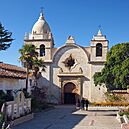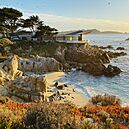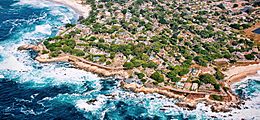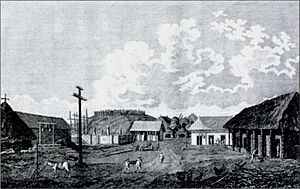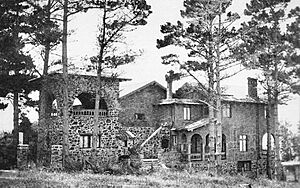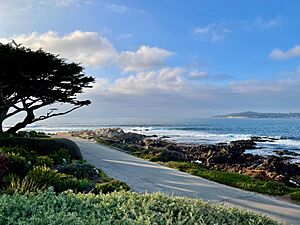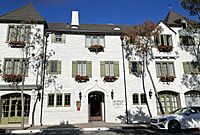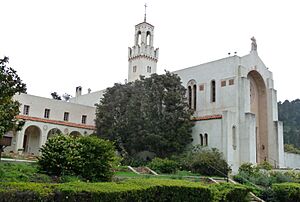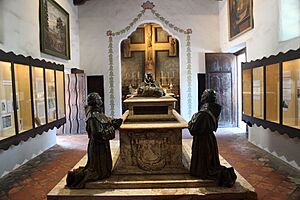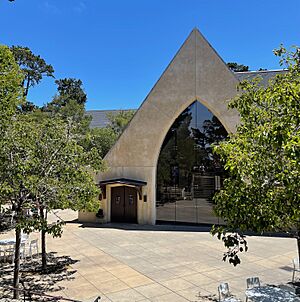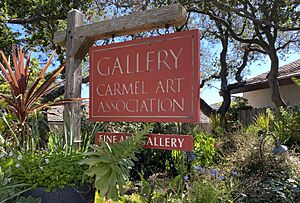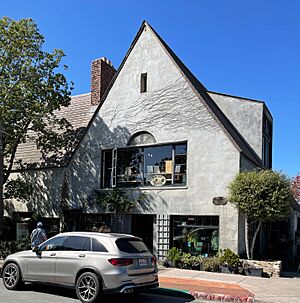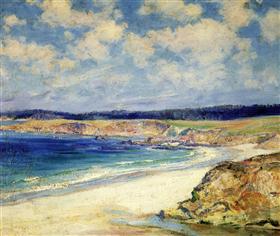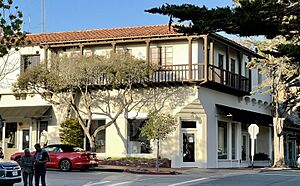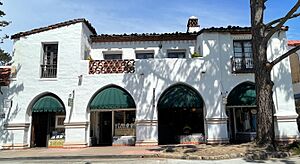Carmel-by-the-Sea, California facts for kids
Quick facts for kids
Carmel-by-the-Sea, California
|
||
|---|---|---|
|
Top: Mission San Carlos Borromeo de Carmelo (left) and Butterfly House (right); middle: storybook architecture (left) and Kocher Building (right); bottom: Carmel coastline
|
||
|
||
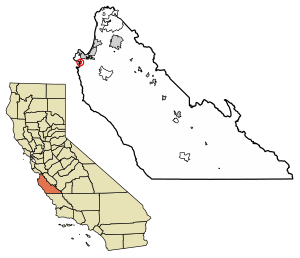
Location of Carmel-by-the-Sea in Monterey County, California
|
||
| Country | United States | |
| State | California | |
| County | Monterey | |
| Incorporated | October 31, 1916 | |
| Area | ||
| • Total | 1.06 sq mi (2.75 km2) | |
| • Land | 1.06 sq mi (2.75 km2) | |
| • Water | 0.00 sq mi (0.00 km2) 0% | |
| Elevation | 223 ft (68 m) | |
| Population
(2020)
|
||
| • Total | 3,220 | |
| • Density | 3,034.87/sq mi (1,171.46/km2) | |
| Time zone | UTC-8 (Pacific) | |
| • Summer (DST) | UTC-7 (PDT) | |
| ZIP codes |
93921–93923
|
|
| Area code | 831 | |
| FIPS code | 06-11250 | |
| GNIS feature IDs | 1658224, 2409987 | |
Carmel-by-the-Sea, often called just Carmel, is a small town in Monterey County, California. It's located on the beautiful Central Coast of California. In 2020, about 3,220 people lived there. Carmel is a popular place for tourists because of its amazing natural views and its long history with art.
The Spanish first started a settlement here in 1797. This happened when Mission San Carlos Borromeo de Carmelo was moved by St. Junípero Serra from Monterey. Mission Carmel was the main center for the Californian mission system. Later, in 1833, the area was divided into large land grants called rancho grants. The settlement was mostly empty by 1848 when the U.S. took over California. It stayed undeveloped until 1888, when Santiago J. Duckworth wanted to build a summer colony there. In 1902, the Carmel Development Company was created, and Carmel became a famous place for artists and a fun seaside resort. It officially became a town in 1916.
Contents
History of Carmel-by-the-Sea
Early Spanish and Mexican Times

The first Europeans to see Carmel were sailors led by Juan Rodríguez Cabrillo in 1542. They sailed along the California coast but did not land. Sixty years later, in 1602, Spanish explorer Sebastián Vizcaíno landed in what is now Carmel Valley. He is believed to have named the river there "Rio Carmelo" to honor the three Carmelite friars (religious brothers) on his trip.
The Spanish didn't try to settle the area until 1770. That's when Gaspar de Portolá, along with priests Junípero Serra and Juan Crespí, looked for a good spot for a mission. Portolà and Crespí traveled by land, while Serra came by ship. The Monterey colony was set up at the same time as the second mission in Alta California and became the capital until 1849. Sadly, many of the native Ohlone people died from European diseases and hard work at the missions during this time.
Mission San Carlos Borromeo de Carmelo was first started on June 3, 1770, in nearby Monterey. But Junípero Serra moved it to Carmel Valley in December 1771. This was because soldiers at the nearby Presidio were causing problems with the native people.
The new Mission Carmel was built with simple plastered mud buildings. Later, a temporary church was made from pine and cypress trees. Eventually, a strong stone church was built. In 1784, Serra passed away and was buried at the Mission, next to Crespí. The Carmel Mission also had California's first library.
When Mexico became independent from Spain in 1821, Carmel became Mexican territory.
Early American Times
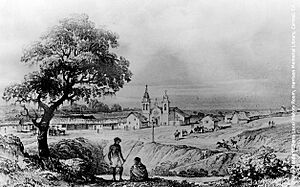
Carmel became part of the United States in 1848. This happened after the Mexican–American War, when Mexico gave California to the U.S.
In the 1850s, a French businessman named Honoré Escolle bought the land that would become Carmel-by-the-Sea. He was well-known in Monterey and owned the first bakery and brickworks there.
In 1856, William Martin and his family arrived from Scotland. His son, John Martin, bought land near the Carmel River in 1859. He built the Martin Ranch, which later became known as the Mission Ranch because it was so close to the Carmel Mission. They grew potatoes and barley and had a dairy farm.
In 1888, Escolle and Santiago J. Duckworth planned out the area. By 1889, 200 land lots were sold. The name "Carmel-by-the-Sea" was first used on a postcard by Abbie Jane Hunter.
Modern Carmel-by-the-Sea
In 1902, James Franklin Devendorf and Frank Hubbard Powers helped plan the main village of Carmel. They asked Michael J. Murphy to build houses, and he built almost 350 buildings in Carmel between 1902 and 1940. The Carmel post office also opened that year. In 1899, Fritz Schweninger opened the first bakery on Ocean Avenue. In 1910, the Carnegie Institution opened a Coastal Laboratory, bringing many scientists to the area. Carmel officially became a town in 1916.
In 1905, the Carmel Arts and Crafts Club was started to support artists. After the big 1906 San Francisco earthquake, many musicians, writers, and painters moved to Carmel. They were offered land lots for a small down payment and easy monthly payments. In 1906, a newspaper called the San Francisco Call wrote a whole page about the "artists, writers and poets at Carmel-by-the-Sea."
The Carmel Arts and Crafts Club held art shows, talks, dances, and plays. They built their own clubhouse in 1907. By 1914, the club was known all over the country.
In 1911, the town began a tradition of putting on plays by Shakespeare. They started with Twelfth Night. This play was also performed in 1940 at the first Carmel Shakespeare Festival.
In 1915, during a big event in San Francisco called the Panama–Pacific International Exposition, Carmel showed off its local products. They also put on a play called Junipero Serra or The Padres at the Forest Theater. This play honored Father Junipero Serra and featured many important Carmel citizens. About 25,000 people watched these performances.

In 1925, Paul Aiken Flanders built the Flanders Mansion. The City of Carmel bought the mansion and its land in 1972. It is now part of the 34-acre Mission Trail Nature Preserve.
In 1932, the city created Devendorf Park. This park is Carmel's main spot for outdoor events and gatherings.
Geography and Climate
Carmel's Location

Carmel is located on the Monterey Peninsula, which is on the southern part of Monterey Bay. This area is part of the Central Coast of California.
Around Carmel, there are special marine protected areas like Carmel Pinnacles State Marine Reserve and Point Lobos State Marine Conservation Area. These areas help protect the ocean and its creatures.
Carmel-by-the-Sea is in an area with a moderate risk of earthquakes. The main threats come from the San Andreas Fault, which is about 30 miles northeast, and the Palo Colorado Fault, which runs offshore.
Carmel's Weather
Carmel-by-the-Sea has a cool summer Mediterranean climate. This type of weather is common in California's coastal areas. Summers are usually mild, with cloudy mornings that often clear up by the afternoon.
September and October, sometimes called "Indian summer," have the nicest weather of the year. The average high temperature is about 72°F (22°C). The rainy season is from October to May.
Carmel-by-the-Sea gets about 20 inches (508 mm) of rain each year. The average temperature is about 57°F (14°C).
| Climate data for Carmel-by-the-Sea | |||||||||||||
|---|---|---|---|---|---|---|---|---|---|---|---|---|---|
| Month | Jan | Feb | Mar | Apr | May | Jun | Jul | Aug | Sep | Oct | Nov | Dec | Year |
| Mean daily maximum °F (°C) | 60.1 (15.6) |
61.0 (16.1) |
64.0 (17.8) |
64.9 (18.3) |
66.9 (19.4) |
68.0 (20.0) |
70.0 (21.1) |
71.1 (21.7) |
70.0 (21.1) |
64.0 (17.8) |
62.1 (16.7) |
60.1 (15.6) |
65.1 (18.4) |
| Mean daily minimum °F (°C) | 43.0 (6.1) |
45.0 (7.2) |
46.9 (8.3) |
48.0 (8.9) |
50.0 (10.0) |
52.0 (11.1) |
53.1 (11.7) |
53.1 (11.7) |
51.1 (10.6) |
46.9 (8.3) |
46.0 (7.8) |
43.0 (6.1) |
48.2 (9.0) |
| Average precipitation inches (mm) | 4.19 (106) |
3.75 (95) |
3.53 (90) |
1.48 (38) |
0.50 (13) |
0.20 (5.1) |
0.09 (2.3) |
0.11 (2.8) |
0.28 (7.1) |
1.06 (27) |
2.43 (62) |
2.73 (69) |
20.35 (517) |
City Planning and Unique Rules
Carmel has always planned its growth carefully to keep its natural beauty. The city wants to remain "a village in a forest overlooking a white sand beach." Carmel-by-the-Sea officially became a town in 1916. By 1925, the town decided it would mostly be a place for homes.
New buildings must be built around existing trees. If a lot doesn't have enough trees, new ones must be planted.
This one-square-mile village has no street lights or parking meters. Also, businesses, cottages, and houses don't have street numbers.
Population of Carmel
| Historical population | |||
|---|---|---|---|
| Census | Pop. | %± | |
| 1920 | 638 | — | |
| 1930 | 2,260 | 254.2% | |
| 1940 | 2,837 | 25.5% | |
| 1950 | 4,351 | 53.4% | |
| 1960 | 4,580 | 5.3% | |
| 1970 | 4,525 | −1.2% | |
| 1980 | 4,707 | 4.0% | |
| 1990 | 4,239 | −9.9% | |
| 2000 | 4,081 | −3.7% | |
| 2010 | 3,722 | −8.8% | |
| 2020 | 3,220 | −13.5% | |
| U.S. Decennial Census | |||
2010 Census Information
In 2010, the 2010 United States Census counted 3,722 people living in Carmel-by-the-Sea. Most of the people (93.1%) were White. About 3% were Asian, and 4.7% were Hispanic or Latino.
All 3,722 people lived in homes. There were 2,095 households, and about 12% of them had children under 18. The average household had 1.78 people.
About 10% of the people were under 18 years old. A large portion, about 35.7%, were 65 years old or older. The average age in Carmel was 59.2 years.
There were 3,417 housing units. About 56% of these homes were owned by the people living in them, and 43.6% were rented.
Arts and Culture in Carmel
Performing Arts Scene
In 1907, Carmel's first cultural center and theater, the Carmel Arts and Crafts Clubhouse, was built. Poets and actors performed there. By 1913, the Arts and Crafts Club started offering lessons for artists and actors.
Theater became very popular in Carmel. Between 1922 and 1924, two indoor theaters were built. One of them, the Theatre of the Golden Bough, burned down in 1935. It was rebuilt and burned down again in 1949, but was rebuilt once more and reopened in 1952.
In 1931, the Carmel Sunset School built a new auditorium with 700 seats. This building was often used for community performances. In 1964, the City of Carmel-by-the-Sea bought it and renamed it the Sunset Theatre. After a big renovation, the Sunset Center reopened in 2003, hosting the 66th annual Carmel Bach Festival.
In 1949, the first Forest Theater Guild was formed. After a period of not being used, a new Forest Theater Guild was started in 1972. They still put on musicals and started a film series in 1997.
Literature and Writers

In 1905, novelist Mary Austin moved to Carmel. She is famous for her book about the deserts of the American Southwest, The Land of Little Rain. Her play, Fire, was first performed at the Forest Theater in 1913. Mary Austin is thought to have suggested the idea for the outdoor stage.

Visual Arts and Photography
In 1906, San Francisco photographer Arnold Genthe joined the Carmel arts community. He did important work in color photography there. He took many portraits of his friends, including famous actors. He wrote that Carmel's "cypresses and rocks of Point Lobos, the always varying sunsets and the intriguing shadows of the sand dunes offered a rich field for color experiments."
The Library of Congress has over 18,000 of his photos. They say Genthe "became famous for his impressionistic portrayals of society women, artists, dancers, and theater personalities."
Photographer Edward Weston moved to Carmel in 1929. He took many nature photos, especially at Point Lobos, south of Carmel Bay. In 1936, Weston was the first photographer to receive a special award called a Guggenheim Fellowship for his experimental photography. In 1948, he took his last photo, an image of Point Lobos, before he became ill. Weston often traveled with the famous photographer Ansel Adams, who moved to the Carmel Highlands in 1962.
Education in Carmel
Carmel is part of the Carmel Unified School District. This district includes schools like Carmel High School, Carmel Middle School, Tularcitos Elementary School, and Carmel River School.
Media in Carmel
Local Newspapers
The Californian, which used to be called The Carmel Sun, was a weekly newspaper published in Carmel-By-The-Sea from 1936 to 1937.
The Carmel Pine Cone is the town's current weekly newspaper. It has been published since 1915. It covers local news, politics, arts, entertainment, opinions, and real estate.
Carmel in Film
In February 2009, the town was a main filming location for the movie The Forger. The film shoot lasted 24 days.
Transportation in Carmel
Carmel-by-the-Sea does not have traffic lights. This helps keep the town's quiet, residential feel.
Bus service is provided by Monterey County's Monterey–Salinas Transit. Carmel is one of the cities connected by Route 5, which ends at Carmel Rancho.
Notable People from Carmel
Actors
- Jean Arthur, actress
- Barbara Babcock, actress
- Ian Bohen, actor
- Doris Day, actress, singer
- Clint Eastwood, actor, film director, mayor of Carmel 1986–1988
- Joan Fontaine, actress
- Brodie Greer, actor
- Craig Kilborn, entertainer, talk show host, comedian
- Sondra Locke (1944–2018), actress, film director
- Stephen Moorer, founder/actor with Pacific Repertory Theatre
- Brad Pitt, actor, film producer
- Jared Safier, Director & Producer
- Dick Sargent, actor
- Jeremy Sumpter, actor
- Betty White (1922–2021), actress
Business Leaders
- Joseph Costello, businessman
- Ingemar Henry Lundquist, inventor and mechanical engineer, known for inventing a method for balloon angioplasty
- Hugh W. Comstock, Carmel designer and builder
- Michael J. Murphy Carmel builder and businessman
Musicians
- Erroll Garner, jazz pianist
- Carrie Lucas, R&B singer
- Michael Nesmith, musician, songwriter and filmmaker
Researchers and Scholars
- Francis Fukuyama, political scientist
- Alison Murray, biochemist and Antarctic researcher
- Ira Remsen, chemist
- Philip Schwyzer, a Shakespeare scholar
Sports Figures
- Andrew Franks, NFL kicker
- Scott Fujita, NFL linebacker
- Atlee Hammaker, former pitcher for the San Francisco Giants.
- Brita Sigourney, Olympian and freestyle skier
- Bob Wartinger, powerboat world champion
- Kerry Woodson, professional baseball player
Visual Artists and Designers
- Ansel Adams, photographer
- Gus Arriola, cartoonist
- Jennie V. Cannon, Artist, author,
- Wah Ming Chang, Hollywood artist, designer/sculptor, Oscar winner
- Eldon Dedini, cartoonist
- Eyvind Earle, artist, author, and illustrator
- Arnold Genthe, photographer
- Pauline Gibling Schindler, arts editor
- Charles Sumner Greene, architect and artist
- Paul Blaine Henrie, artist
- Hank Ketcham, cartoonist
- Xavier Martínez, painter
- William Frederic Ritschel, painter
- Esther Rose, Western artist
- John Edward Walker (1880–1940) California Impressionist painter.
- Edward Weston, photographer
- Francis Whitaker, Carmel blacksmith artist, Forge in the Forest prior 1962
- Steven Whyte, sculptor
- Shirley Williamson (1875–1944) California Impressionist painter.
Writers, Novelists, and Journalists
- Mary Hunter Austin, novelist
- Eric Berne, psychiatrist and author
- Gelett Burgess, humorist, author
- Meg Cabot, author, wrote The Mediator series, set in Carmel
- Beverly Cleary, author, wrote books about characters like Ramona Quimby and Henry Huggins (1915–2021)
- Charlie Fern, former White House speech writer, journalist
- Colin Fletcher, writer
- Nora May French, poet
- Robert A. Heinlein, author
- Darrell Huff, author, writer, architect
- Robinson Jeffers, poet
- Christopher Kasparek, writer, translator, physician
- Anna Kavan, British novelist
- Charlotte Hoffman Kellogg (1874–1960), author and social activist who was friends with Marie Curie.
- Sinclair Lewis, novelist
- Jack London, novelist
- Hugo Schwyzer, writer and feminist
- Upton Sinclair, novelist and social reformer
- George Sterling, poet
- Lincoln Steffens, writer
- Robert Louis Stevenson, author
- Henry Meade Williams
- Mona Williams
Other Notable People
- Roy Chapman Andrews, naturalist and explorer
- Father Junipero Serra, a Roman Catholic Spanish priest, Catholic saint.
See also
 In Spanish: Carmel-by-the-Sea para niños
In Spanish: Carmel-by-the-Sea para niños


